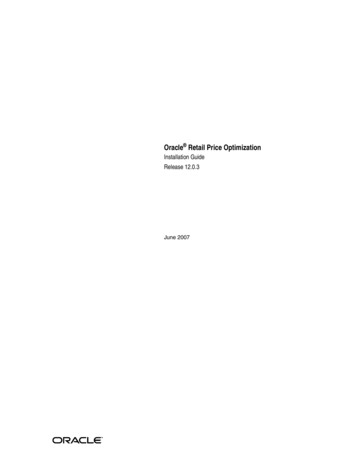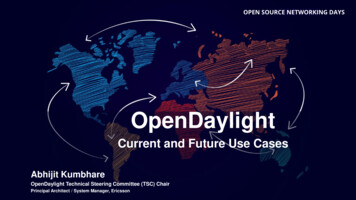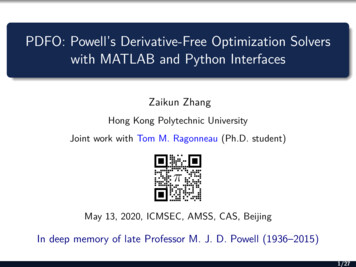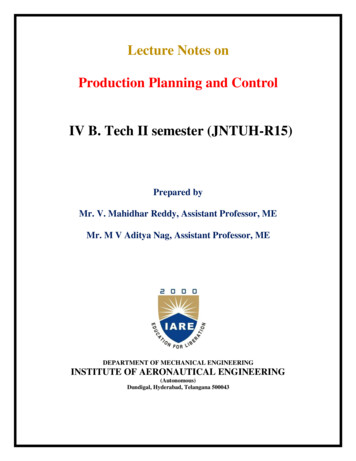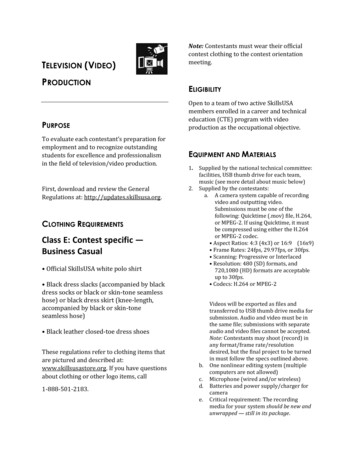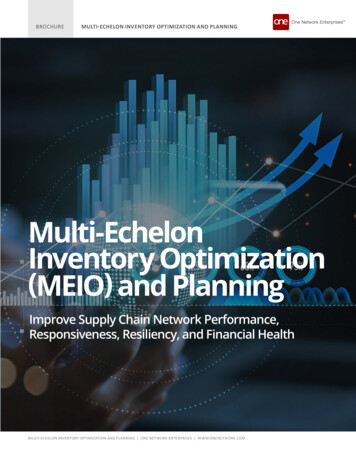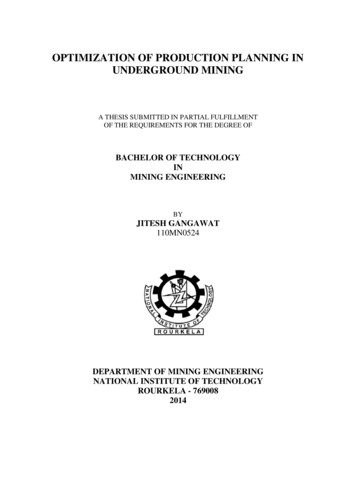
Transcription
OPTIMIZATION OF PRODUCTION PLANNING INUNDERGROUND MININGA THESIS SUBMITTED IN PARTIAL FULFILLMENTOF THE REQUIREMENTS FOR THE DEGREE OFBACHELOR OF TECHNOLOGYINMINING ENGINEERINGBYJITESH GANGAWAT110MN0524DEPARTMENT OF MINING ENGINEERINGNATIONAL INSTITUTE OF TECHNOLOGYROURKELA - 7690082014
OPTIMIZATION OF PRODUCTION PLANNING INUNDERGROUND MININGA THESIS SUBMITTED IN PARTIAL FULFILLMENTOF THE REQUIREMENTS FOR THE DEGREE OFBACHELOR OF TECHNOLOGYINMINING ENGINEERINGBYJITESH GANGAWAT110MN0524Under the guidance ofPROF. D. S. NIMAJEPROF. S. CHATTERJEEDEPARTMENT OF MINING ENGINEERINGNATIONAL INSTITUTE OF TECHNOLOGYROURKELA - 7690082014
National Institute of Technology,RourkelaCERTIFICATEThis is to certify that the thesis entitled “OPTIMIZATION OF PROCUCTIONPLANNING IN UNDERGROUND MINING” submitted by Sri JITESH GANGAWATin partial fulfilment of the requirements for the award of Bachelor of Technology degree inMining Engineering at the National Institute of Technology, Rourkela is an authentic workcarried out by him under our supervision and guidance.To the best of our knowledge, the matter embodied in the thesis has not been submitted toany other University/Institute for the award of any Degree or Diploma.Prof. D. S. NimajeAssistant ProfessorDept. of Mining EngineeringNational Institute of TechnologyRourkela - 769008Prof. S. ChatterjeeAssistant ProfessorDept. of Mining EngineeringNational Institute of TechnologyRourkela - 769008
CONTENTSACKNOWLEDGEMENTIIABSTRACTIIILIST OF TABLES AND FIGURESIVChapter 1 : Introduction1-41.1 General21.2 Objective4Chapter 2 : Literature review5-92.1 Previous research62.2 Open stoping method7Chapter 3 : Methodology10-143.1 Introduction113.2 Assumptions113.3 Notations3.3.1 Constants3.3.2 Decision variables1111123.4 Objective function123.5 Constraints3.5.1 Stope extraction angle constraint3.5.2 Minimum Stope height constraint3.5.3 Maximum Stope height constraint13131414Chapter 4 : Case study15-18Chapter 5 : Results and Discussions19-285.1 Stope design formulation205.2 Production scheduling formulation5.2.1 Mining Constraint5.2.2 Processing constraint232324Chapter 6 : Conclusions29-30Chapter 7 : References31-34I
ACKNOWLEDGEMENTI wish to express my deep reverence and gratitude to my supervisor Prof. S. Chatterjee for hisinspiring guidance, help, constructive criticism and valuable suggestions during this projectwork. I find words inadequate to thank him for his encouragement and effort in improvingmy understanding of this project.I am also grateful to Prof. D. S. Nimaje who allowed me to work on the topic of my interestand for his guidance and suggestions throughout this project work.I am also thankful to Mr. Javed Alam and Mr. Shashi Shukla for their assistance and helpduring mine visit.Last but not least, my sincere thanks to all my friends who have patiently extended all sorts ofhelp for accomplishing this work.Date:JITESH GANGAWATDept. of Mining EngineeringNational Institute of TechnologyRourkela-769008II
ABSTRACTUse of Integer programming (IP) or mixed integer programming (MIP) for formulation ofmine optimization problem is best suited modelling approach for underground mining.Optimization algorithm for underground stope design problems cannot be generalised asgeotechnical constraints for each method is different. This project concentrates onoptimization model for open stoping mining method. The stope design model maximizes Netcash flow of the stope while adhering to the stope constraints. The methodology considersopen stoping sequence, in which every block is moved towards the cross-cuts at the lowerlevel. In this thesis, stopes are designed to maximize the undiscounted cash flow from thestope after satisfying stope height and extraction angle constraints. An integer programmingformulation is developed and solved using CPLEX solver for single stope. The proposedalgorithm is solved for first stope and then blocks for the crown pillar for first stope isidentified. After eliminating the first stope and respective crown pillar data from the data set,algorithm is solved again for the second stope from the remaining data set. After stopedesign, production scheduling is done by applying heuristic approaches. Blocks from thestopes are extracted heuristically satisfying extracting angle, mining and processingconstraints. Initially blocks from the first stope are selected and then to fulfil the constraints,some of the blocks from the second stope are selected. A study is carried out on the part ofthe Zinc mine data of India which contains 4992 number of blocks. Total 3 numbers of stopesare designed. The NPV of the considered data is found to be 7313.346 million rupees in 3periods with total tonnage of 1.103 million tonnes. Metal content in 3 periods is found to be86.485 thousand Tonnes. The overall dilution is found to be 3.82% with average dilution of2.692%.III
LIST OF TABLES AND FIGURESTablesTable 4.1: Tonnage for dfferent-different cut-off grrades . 18Table 5.1: Constant parameters and their values . 20Table 5.2: Values of the different parameters from the optimal solution . 21Table 5.3: Stope parameters . 21Table 5.4: Values of the different production scheduling parameters . 24FiguresFigure 2.1: Underground mine layout (Bley et al., 2012) . 8Figure 2.2: Description of the underground mining operations (Epstein et al., 2012) . 9Figure 3.1: Position of predecessor blocks (a) 3-D view (b) node view. 13Figure 3.2: Notation of 9 predecessor blocks with their position . 13Figure 4.1: X-Z view of the data . 16Figure 4.2: 3-D view of the data . 17Figure 4.3: Histogram of the grade . 17Figure 4.4: Grade-Tonnage curve . 18Figure 5.1: Y-Z and X-Z view of the final solution . 22Figure 5.2: 3-D view of the final solution. 23Figure 5.3: X-Z section of the data showing production scheduling . 25Figure 5.4: Tonnage extracted for different periods . 25Figure 5.5: Graph showing metal production in each period. 26Figure 5.6: Bar graph showing DCF in each period . 27Figure 5.7: Graph showing cumulative NPV over the periods . 27Figure 5.8: Graph showing the cumulative dilution over the periods. 28IV
Chapter 1 : IntroductionGENERALOBJECTIVE1
1. INTRODUCTION1.1 GENERALMining is the process of excavating a material which is naturally occurring from the earth toget profit. Underground method is used when ore body is thin or narrow and extends muchbelow surface (Newman et al., 2010). In underground mining, development required to reachthe orebody is much and increases the production time from the start of the development(Haycocks, 1992). Effective mine planning is required to generate profit (Carlyle et al.,2001). Mine production scheduling is an important problem in mine planning (Gershon,1983). Main objective of the production scheduling is to maximize cash flow and it is also themain objective of all the mining industries. Before the use of computers in planning, it wasdone manually and based on the sections and graph created by the persons, this work takes alot of time and is bit tedious and efficiency also depends on the individuals. But now days,operation research techniques are used to define or optimize any process or activities(Newman et al., 2010). These techniques are faster and more work is being carried out todecrease the computational time. Solutions obtained from these techniques are close to thereal values.Production scheduling can be defined as the allocation of resources/reserves over a timeperiod with particular sets of constraints (Martinez et al., 2011). Mine production schedulingis an optimization process which assigns the extraction sequence of mining blocks based onthe constraints which incorporate method of mining, slope, stope size, etc such that itmaximizes the net present value (NPV) of a mine (Kuchta et al., 2003). There are two typesof mine production scheduling: long-term production scheduling and short-term productionscheduling (Nehring et al., 2012). Long-term production scheduling is done over life of themine. In Short-term production scheduling, result generated from the long-term productionscheduling is broken down according to task or time period that need to be studied anddifferent sets of constraints active in short-term is applied minimize the deviations from thepre-defined capacities.Generally, production schedule is based on the block model of the ore body generated by theinterpolation techniques, such as Kriging (Hugh and Davey, 1979), from the drillhole sampledata. Block model can be transformed into the economic block model knowing mining cost,metal price, metal recovery and ore density (Lane, 1988). This model is considered to be fair2
representation of the ore body. Then this block model is used for optimization of productionscheduling. Scheduling problem mainly consists of 3 steps: (a) deciding the extractionsequence of blocks satisfying slope and mining method constraints and produces the optimumNet Present Value (NPV), (b) designing different mining phases based on the optimumsequence, and (c) optimizing the production schedule and cut off grades (Menabde et al.,2004). The NPV of this optimum schedule found is taken as a main criterion of the viabilityof the project.Use of Integer programming (IP) or mixed integer programming (MIP) for formulation ofmine scheduling optimization problem is best suited modelling approach. In this approach,model includes objective function which tries to maximize NPV over the pre decided timeperiod and constraints which take in geotechnical considerations, mining methodconsiderations, mining and processing capacities, cut off grades, etc (Lamghari et al., 2010).Geotechnical constraints on the stope shape pertain to angle of repose of the material,minimum and maximum stope dimensions (Smith, 2003). As it is known that, geotechnicalconstraints vary according to the mining methods used. All methods have different-differentapproaches. Therefore, a general optimization algorithm cannot be defined for allunderground mining methods. In open pit optimization, lower level blocks are linked with theblocks of upper level based on the wall angles of open pit. Lerchs-Grossman algorithm(Lerchs and Grossman, 1965) and network flow (Picard, 1976) concepts are the bestapproaches to solve these problems. These techniques cannot be applied directly to theunderground mining problems, but can be used if all the constraints leaving the slopeconstraint are embedded in the objective problem itself (Dagdelen and Johnson, 1986). As inopen pit problems, every block is moved towards the free surface and in this case the freesurface is ground. Likewise in underground problems, an initial free surface is created &differs in every method, can be in form of raise or ore pass or cross-cuts, and every block ispushed towards the free surface. This translates the problem into a network flow problemwhich can be solved by following open pit techniques (Bai, 2013).Underground stope design contains stope extraction angle constraint, stope height constraint.This problem cannot be solved by either using Lerchs-Grossman algorithm or using networkflow concepts due to non-unimodularity of constraint matrix. That is why in this project,problem is divided in two stages. First stope design problem is formulated as IntegerProgramming (IP) which is solved using branch and cut algorithm. Then productionscheduling problem on the generated solution is solved by applying heuristic approaches.3
Heuristic approaches give solution which is close to the optimal solution but is not an optimalsolution; however computational time can significantly be reduced.1.2 OBJECTIVE1. To optimally design stopes for open stoping method based on constraints of stopeextraction angle and stope height.2. To do production scheduling of the generated stopes by applying heuristicapproaches.4
Chapter 2 : Literature reviewPREVIOUS RESEARCHOPEN STOPING-UNDERGROUND MINING METHOD5
2. LITERATURE REVIEW2.1 Previous researchUse of operations research (OR) techniques in mine planning is widely used. Most of themodels developed so far are for open-pit mines which only solve the part of the long-termplanning problem (Newman et al., 2010). Optimization of either open-pit or undergroundproblems has been divided in two parts: the ultimate pit problems which determines the finalpit in open-pit case or stope design problem which optimizes the stopes; and the productionscheduling problems which determines the extraction sequence of the blocks with respect totime period.Use of OR techniques started with solving the ultimate pit problem. Kim (1978) presents theclassic moving cone algorithm which selects a block as a reference and expands upwardsbased on the sloping criteria. This algorithm gives sub-optimal solution only. But thealgorithm given by the Lerchs and Grossmann (1965) that gives the optimal solution. Forsolving the production scheduling problem, Gershon (1983) gives mixed integerprogramming formulation, Towlanski et al. (1996) presents use of dynamic programmingapproach, and Caccetta and Hill (2003) presents an algorithm which uses branch and cut.Kuchta et al. (2003) presents the MIP model for underground mine which aims at minimizingthe deviations from the pre-defined targets. Likewise Martinez et al. (2011) present a solutionapproach which optimizes the long- and short-term production scheduling. They developedan optimization based decomposition heuristics which gives better and faster solutions.Bakhtaver et al. (2012) present a (0-1) integer programming model which optimizes thetransition from open-pit to underground mining.Research on sequencing models for underground mining is relatively new. Earlier models uselinear programming and simulation to determine production schedules and decisions relatedto ore extraction. Jawed (1993) uses linear programming to minimize the deviations from themining capacities subjected to operational constraints. Author considered room and pillarmining method as a reference for effective design. Carlyle et al. (2001) presents a mixedinteger programming model which considers several planning constraints. This model wasapplied to only one sector of the underground platinum mine. Smith et al. (2003) uses mixedinteger programming (MIP) for life of mine planning which is aimed at maximizing the cashflow based on detailed production scheduling study and the operational constraints. But the6
solution time for solving all the instances took sound amount of time. Newman et al. (2007)uses a small model in which time period is aggregated and then solved using heuristicapproaches. This aggregated model serves as a base and the information gained from thismodel is used to solve the original model which tries to minimize the deviation from theplanned production quantities. Grieco et al. (2007) presents a probabilistic mixed integerprogramming model to optimize the underground open stoping situations. This methodologyincludes location, size, and number of stopes with uncertainty in grade and acceptable risklevels. Epstein et al. (2012) presents a methodology based on the multicommodity networkflow which considers that open pit and underground deposits share multiple downstreamprocessing plants over the time horizon. This model tries to integrate several mines and thenoptimize them. Author uses block caving method as a reference for optimization of theunderground mine. Nehring et al. (2012) presents a methodology for sublevel stoping methodwhich tries to integrate the short term and medium term production plans by combining theshort term objective (to minimize the deviation from the target) and medium term objective(to maximize the net present value). Bai et al. (2013) presents an algorithm for sublevelstoping method which tries to optimize stope design. Methodology is based on the location ofvertical raise and then conversing the blocks towards it. Optimization program is transformedto a maximum flow over the graph problem by adding source and sink node.2.2 Open stoping methodUnderground mining methods are generally categorised in 3 categories: unsupportedmethods, supported methods, and caving methods. Generally mining method is determinedby the geotechnics and not by the OR techniques. Mining method determination depends onsize of the orebody, shape of the orebody, and characteristics of the ore and the surroundingrock (Newman et al., 2010).Open stoping underground methods are used where orebody strength vary from moderate tostrong with low discontinuities. Hang wall and foot wall strength need to be good and doesnot require more than incidental support (Haycocks, 1992).In open stoping method, first of all levels are created which act as a haulage road and dividesthe orebody in stoping blocks as shown in Figure 2.1 Stoping blocks are extracted accordingto the sequence method used and mainly depends on the orientation and thickness of theorebody. For extraction of the stoping blocks, they are divided into panels and the ore passand raises are created for access between them.7
Figure 2.1: Underground mine layout (Bley et al., 2012)Figure 2.2 shows the flow in an underground mine. First of all broken ore is loaded from thedraw points along parallel crosscuts. Load haul dumpers (LHD) are used in this operation andthe crosscuts have enough space for smooth working of LHDs. LHDs dumped the material inthe ore passes which opens in the internal crusher. Internal crusher is used for size reductionand the material is then transported to the processing plant outside mine through the shaft andthen by the train (Epstein et al., 2012).8
Figure 2.2: Description of the underground mining operations (Epstein et al., 2012)9
Chapter 3 : VE FUNCTIONCONSTRAINTS10
3. METHODOLOGY3.1 IntroductionIn optimization problem formulation, first of all objective function is formed, transferring therequired problem in the form of a mathematical equation. Then to meet the different criteria,constraints are formed and expressed in the manner of mathematical equations. Constraintshelp in determining the feasible solution. In this project, the underground stope designoptimization problem is formulated as Integer Programming (IP).3.2 AssumptionsBefore formulating the underground mine production scheduling problem, number of thingsare assumed. These are:1. Access to the ore body is fully developed and is in working order.2. Development required for production activities like drilling, blasting, loading,unloading is done before hand and is in working order.3. Open stoping mining method is used for extraction.4. Size of the stoping blocks is known based on the thickness of the orebody, depth ofthe orebody.5. Size of the crown pillar is fixed and is decided by the stress analysis of the differentopenings and extractions in different manner as decided by the geotechnicalparameters.3.3 Notations3.3.1 ConstantsG[i,j,k]Grade value of the (i, j, k)th block (%)OPSelling price of the metal (rupees per tonne)PCCost of processing of the ore (rupees per tonne)MCCost of mining of the ore (rupees per tonne)BMTonnage of single Block (tonne)MNumber of blocks in X directionNNumber of blocks in Y directionONumber of blocks in Z directionMNMinimum number of blocks in Z direction in one stoping block11
MXMaximum number of blocks in Z direction in one stoping blockCOGCut off grade for a particular type (%)MINMMinimum tonnage that need to be mined in one period (tonne)MAXMMaximum tonnage that need to be mined in one period (tonne)MINPMinimum tonnage that need to be processed in one period (tonne)MAXPMaximum tonnage that need to be processed in one period (tonne)3.3.2 Decision variablesX [i, j, k]1if (i, j, k)th block is in stope0otherwise3.4 Objective functionMain objective of the mining companies is to maximize the profit from different-differentactivities. Keeping that in mind, objective function in this project tries to maximize the Netcash flow from single stope. The profit from single block can be calculated by the economicfunction as follows (Lane, 1988):Where, ‘i’ represents the block, di is the density of the block, vi is the block volume, gi is theaverage grade of block, r is the recovery, s is the unit selling price, and c is the unit miningand processing costs. Present value of the money received at the end of each period can becalculated as follows:Where, M is the amount money received at the end of tth period, ‘i’ is the interest rate, and t istime period index.Based on the above concepts, the objective function which is aimed at maximizing cash flowfrom single stope is as follows:12
Note that the development costs i.e. costs to create the way in to the stopes, are notconsidered in cash flow calculations as these costs are assumed to be same for all possiblestope.3.5 Constraints3.5.1 Stope extraction angle constraintTo reach a given block, all the blocks lying below it as shown in the Figure 3.1 referred to asits predecessors, need to be extracted first.Figure 3.1: Position of predecessor blocks (a) 3-D view (b) node viewThis constraint ensures that a block is mined only after its predecessor blocks are mined.Notations of the predecessor block for a particular block (i, j, k) is given in the Figure 3.2.Figure 3.2: Notation of 9 predecessor blocks with their position13
Mathematical form of this constraint is as follows:Where, p is the set which contains {-1, 0, 1}.For blocks which reside in sides, only six blocks will act as a predecessor block. If theyreside in left hand side then (j-1) blocks will not be there and if they reside in right hand sidethen (j 1) blocks will not be there. For corner blocks, only four blocks need to be mined first.3.5.2 Minimum Stope height constraintExtraction of each and every block in underground mining based on the technical andeconomic point of view is conditional upon extracting all the blocks which are adjacent to it.It can be say that a block is mined only if the other blocks adjacent to it have the potential tobe extracted.This constraint ensures that a given stope contains at least minimum number of blocks. Themathematical equation governing this constraint is as follows:3.5.3 Maximum Stope height constraintDimension of a stope must be restricted through the adjacent blocks in vertical direction fromthe technical point of view. If not restricted then roof failure and sagging problem might ariseand can cause accidents.This constraint restricts the number of blocks within a given stope, so it does not get past themaximum allowable limit. The mathematical logic for this constraint is as follows:14
Chapter 4 : Case study15
4. CASE STUDYThe case study data are collected from an Indian zinc mine which is located at the location(24057 , 74008 ). Strike length of the mine is 4.5 km with width ranging from 2 m to 40 m.Total of 128 boreholes for exploration purpose and 800 m of exploratory mining is done. Theorebody is in 2 parts and designated as north lode and south lode. The cut-off grade is 3%(Zn Pb). Average zinc content is found to be 5.5 % and lead content to be 1.2 % in the northlode and 1.37 % Pb and 5.9 % Zn in the southern part of the deposit. In the ore, zinc is themain base metal which is followed by the lead and copper and small quantities of silver,arsenic, and mercury. The stope design study is carried out on the eastern part of the mineand data lies in the square of area 0.194 km2.Data contains total of 4992 blocks. There are total of 12 blocks in X direction, 16 blocks in Ydirection, and 26 blocks in Z direction. The dimension of a single block is 2.5 m * 5 m *8.33 m. Specific gravity of the ore is considered to be 3. Height of the crown pillar isconsidered to be around 25 m. So, 3 blocks are left as a crown pillar.Figure 4.1 shows X-Z plane of the data and colour variation is according to the grade value ofthat specific block whereas Figure 4.2 shows 3-D view of the data.Figure 4.1: X-Z view of the data16
Figure 4.2: 3-D view of the dataFigure 4.3 shows the histogram of the grade value of the data. It contains number of blocksfor different-different range of grade value. Given data is normally distributed based on thevisual inspection. It shows that data contains more number of blocks for the grade rangingfrom 5-9 %.Figure 4.3: Histogram of the grade17
Table 4.1: Tonnage for dfferent-different cut-off grradesCut -off grade (%)01.534.567.5910.51213.5Total tonnage 97Table 4.1 shows tonnage value with respect to the cut-off grade value. This data with gradetonnage curve is helpful in determining the feasible cut-off grade and respective tonnage thatis available for extraction and processing. Figure 4.4 shows the grade-tonnage curve of thedata of part of the zinc mine. This graph shows the quantity of material that is available if thatgrade is selected as a cut off grade. This helps in economical analysis of the data. For a cutoff grade 3 % that is used in planning at the mine, tonnage available for processing is 1.466Million tonnes out of 1.56 million tonnes.1.81.6Tonnage (MTs)1.41.210.80.60.40.20051015Grade (%)Figure 4.4: Grade-Tonnage curve1820
Chapter 5 : Results and DiscussionsSTOPE DESIGN FORMULATIONPRODUCTION SCHEDULING FORMULATION19
5. RESULTS AND DISCUSSIONSThere are total of 4992 blocks in the part of the zinc mine of india of size 2.5 m * 5 m * 8.33m. Blocks are arranged in the manner like 12 blocks in X direction, 16 blocks in Y direction,and 26 blocks in Z direction. Tonnage of the single block is calculated to be 312.5 T asspecific gravity is considered to be 3. Selling price of the Zinc metal is considered as ecommodities(www.hzlconnect.com). The mining cost and the processing cost for the underground miningis calculated based on the information given by the O’Hara et al. (1992). As per theinformation obtained from the zinc mine of India, the crown pillar thickness is assumed to be25 m i.e. equal to the combined height of the 3 blocks.Table 5.1: Constant parameters and their valuesParametersValuesMining costProcessing costRecoverySelling priceSpecific gravityBlock Mass2100 Rs/ton of ore1000 Rs/ton of ore0.9155000 Rs/ton of metal3312.5 tonneValue of some of the constant parameters is given in the Table 5.1 and some of the valuestaken is as follows: minimum and maximum height of the single stope to be 33.3 m and 58.3m respectively, minimum and maximum mining values to be 0.24 MT and 0.42 MTsrespectively, minimum and maximum metal production values to be 35 thousand tonne and20 thousand tonne respectively.5.1 Stope design formulationProblem is written in the ZIMPL (Koch, 2004) which is then solved with the CPLEX (IBM,2012) commercial solver. This algorithm is valid for optimization of single stope only. So,algorithm is solved first for first stope starting from the base of the data set and proceedingupwards. Formulation is started from below because the location of the crusher and skip isnear this starting point. After obtaining the result, the first stope data is then eliminated fromthe problem set. After leaving the crown pillar as required, the algorithm is solved again for20
second stope from the remaining data set. This process is repeated till the block count reachesmaximum. The result obtained is that data contains 3 stopes.Cash flow, tonnage, dilution, and metal content of each stope are calculated using thesolution obtained. Dilution refers to the waste material that is mined with the ore and notseparated from the ore material during the operation. It is mixed with the ore and sent to thematerial. Dilution increases the tonnage to be mined while decreasing the grade of thematerial that is to be processed. It can be calculated as follows:Table 5.2: Values of the different parameters from the optimal solutionStopeTonnage ofNumber stopes (MTs)Cash flow fromDilutionMetal content ofstopes (Crore Rs.)(%)stope (thousand 3305.17.36430.61Table 5.2 shows the value of the different parameters that is determined from the optimumsolution data. This shows that third stope contains more tonnage and first stope contains lesstonnage, it is because of the fact that number of blocks whose economic value is less isaggregated at the top of the first stope. From the data, it is seen that metal content of the thirdstope is less as compared to second stope despite of more tonnage. It is because of thedilution in the third stope is more as compared.Table 5.3: Stope parametersStopesNo. of blocksin a stopeMinimumheight (m)Maximumheight (m)No. of wasteblocks1239861253129033.3335041
Mining is the process of excavating a material which is naturally occurring from the earth to get profit. Underground method is used when ore body is thin or narrow and extends much below surface (Newman et al., 2010). In underground mining, development required to reach

